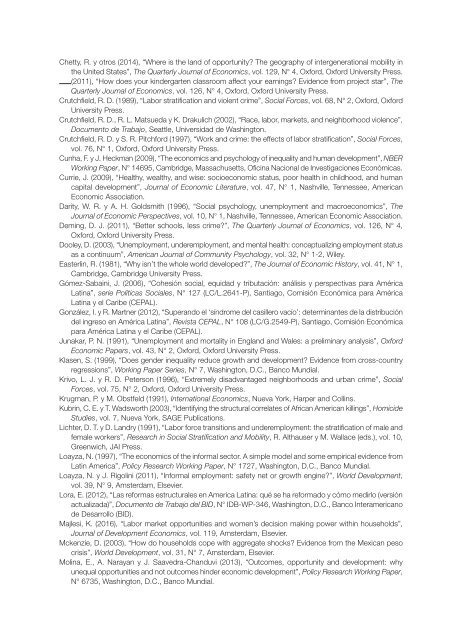Revista CEPAL no. 125
Agosto 2018
Agosto 2018
You also want an ePaper? Increase the reach of your titles
YUMPU automatically turns print PDFs into web optimized ePapers that Google loves.
Chetty, R. y otros (2014), “Where is the land of opportunity? The geography of intergenerational mobility in<br />
the United States”, The Quarterly Journal of Eco<strong>no</strong>mics, vol. 129, N° 4, Oxford, Oxford University Press.<br />
(2011), “How does your kindergarten classroom affect your earnings? Evidence from project star”, The<br />
Quarterly Journal of Eco<strong>no</strong>mics, vol. 126, N° 4, Oxford, Oxford University Press.<br />
Crutchfield, R. D. (1989), “Labor stratification and violent crime”, Social Forces, vol. 68, N° 2, Oxford, Oxford<br />
University Press.<br />
Crutchfield, R. D., R. L. Matsueda y K. Drakulich (2002), “Race, labor, markets, and neighborhood violence”,<br />
Documento de Trabajo, Seattle, Universidad de Washington.<br />
Crutchfield, R. D. y S. R. Pitchford (1997), “Work and crime: the effects of labor stratification”, Social Forces,<br />
vol. 76, N° 1, Oxford, Oxford University Press.<br />
Cunha, F. y J. Heckman (2009), “The eco<strong>no</strong>mics and psychology of inequality and human development”, NBER<br />
Working Paper, N° 14695, Cambridge, Massachusetts, Oficina Nacional de Investigaciones Económicas.<br />
Currie, J. (2009), “Healthy, wealthy, and wise: socioeco<strong>no</strong>mic status, poor health in childhood, and human<br />
capital development”, Journal of Eco<strong>no</strong>mic Literature, vol. 47, N° 1, Nashville, Tennessee, American<br />
Eco<strong>no</strong>mic Association.<br />
Darity, W. R. y A. H. Goldsmith (1996), “Social psychology, unemployment and macroeco<strong>no</strong>mics”, The<br />
Journal of Eco<strong>no</strong>mic Perspectives, vol. 10, N° 1, Nashville, Tennessee, American Eco<strong>no</strong>mic Association.<br />
Deming, D. J. (2011), “Better schools, less crime?”, The Quarterly Journal of Eco<strong>no</strong>mics, vol. 126, N° 4,<br />
Oxford, Oxford University Press.<br />
Dooley, D. (2003), “Unemployment, underemployment, and mental health: conceptualizing employment status<br />
as a continuum”, American Journal of Community Psychology, vol. 32, N° 1-2, Wiley.<br />
Easterlin, R. (1981), “Why isn’t the whole world developed?”, The Journal of Eco<strong>no</strong>mic History, vol. 41, N° 1,<br />
Cambridge, Cambridge University Press.<br />
Gómez-Sabaini, J. (2006), “Cohesión social, equidad y tributación: análisis y perspectivas para América<br />
Latina”, serie Políticas Sociales, N° 127 (LC/L.2641-P), Santiago, Comisión Económica para América<br />
Latina y el Caribe (<strong>CEPAL</strong>).<br />
González, I. y R. Martner (2012), “Superando el ‘síndrome del casillero vacío’: determinantes de la distribución<br />
del ingreso en América Latina”, <strong>Revista</strong> <strong>CEPAL</strong>, N° 108 (LC/G.2549-P), Santiago, Comisión Económica<br />
para América Latina y el Caribe (<strong>CEPAL</strong>).<br />
Junakar, P. N. (1991), “Unemployment and mortality in England and Wales: a preliminary analysis”, Oxford<br />
Eco<strong>no</strong>mic Papers, vol. 43, N° 2, Oxford, Oxford University Press.<br />
Klasen, S. (1999), “Does gender inequality reduce growth and development? Evidence from cross-country<br />
regressions”, Working Paper Series, N° 7, Washington, D.C., Banco Mundial.<br />
Krivo, L. J. y R. D. Peterson (1996), “Extremely disadvantaged neighborhoods and urban crime”, Social<br />
Forces, vol. 75, N° 2, Oxford, Oxford University Press.<br />
Krugman, P. y M. Obstfeld (1991), International Eco<strong>no</strong>mics, Nueva York, Harper and Collins.<br />
Kubrin, C. E. y T. Wadsworth (2003), “Identifying the structural correlates of African American killings”, Homicide<br />
Studies, vol. 7, Nueva York, SAGE Publications.<br />
Lichter, D. T. y D. Landry (1991), “Labor force transitions and underemployment: the stratification of male and<br />
female workers”, Research in Social Stratification and Mobility, R. Althauser y M. Wallace (eds.), vol. 10,<br />
Greenwich, JAI Press.<br />
Loayza, N. (1997), “The eco<strong>no</strong>mics of the informal sector. A simple model and some empirical evidence from<br />
Latin America”, Policy Research Working Paper, N° 1727, Washington, D.C., Banco Mundial.<br />
Loayza, N. y J. Rigolini (2011), “Informal employment: safety net or growth engine?”, World Development,<br />
vol. 39, N° 9, Amsterdam, Elsevier.<br />
Lora, E. (2012), “Las reformas estructurales en America Latina: qué se ha reformado y cómo medirlo (versión<br />
actualizada)”, Documento de Trabajo del BID, N° IDB-WP-346, Washington, D.C., Banco Interamerica<strong>no</strong><br />
de Desarrollo (BID).<br />
Majlesi, K. (2016), “Labor market opportunities and women’s decision making power within households”,<br />
Journal of Development Eco<strong>no</strong>mics, vol. 119, Amsterdam, Elsevier.<br />
Mckenzie, D. (2003), “How do households cope with aggregate shocks? Evidence from the Mexican peso<br />
crisis”, World Development, vol. 31, N° 7, Amsterdam, Elsevier.<br />
Molina, E., A. Narayan y J. Saavedra-Chanduvi (2013), “Outcomes, opportunity and development: why<br />
unequal opportunities and <strong>no</strong>t outcomes hinder eco<strong>no</strong>mic development”, Policy Research Working Paper,<br />
N° 6735, Washington, D.C., Banco Mundial.


















